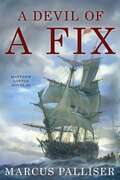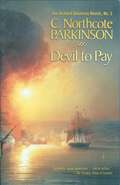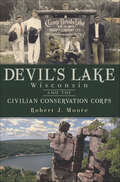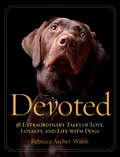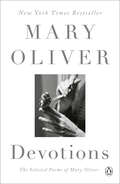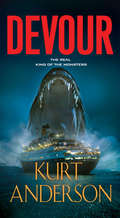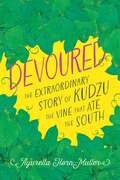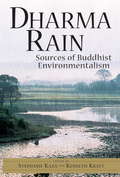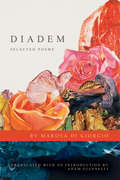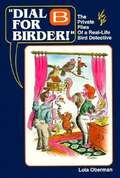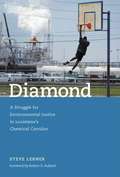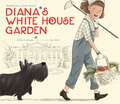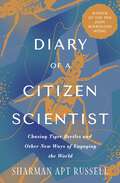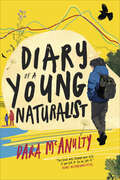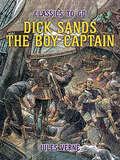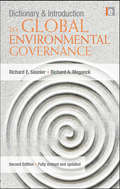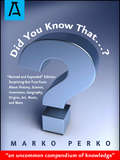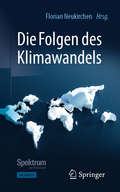- Table View
- List View
Developments in Soil Salinity Assessment and Reclamation
by Shabbir A. Shahid Mahmoud A. Abdelfattah Faisal K. TahaThe papers assembled here cover topics such as technological advances in soil salinity mapping and monitoring, management and reclamation of salt-affected soils, use of marginal quality water for crop production, salt-tolerance mechanisms in plants, biosaline agriculture and agroforestry, microbiological interventions for marginal soils, opportunities and challenges in using marginal waters, and soil and water management in irrigated agriculture.
Devil of a Fix
by Marcus PalliserIt is 1702, and in the lawless Caribbean Sea, young Matthew Loftus captains his ship, the Cornelius, and vows to engage in honest trade rather than piracy and plunder. But his crew lusts after the spoils that their fast, well-armed vessel could win, and discontent begins to rumble. Meanwhile, Loftus is pursued by the English Navy on a false charge of mutiny. Matthew must evade the King&’s ships and escape the attention of ruthless privateers. His only chance of pardon rests with a secret almanac that promises that elusive prize—to solve the Longitude Problem. But is the almanac what it seems? Through wild gales and fierce sea battles, uprisings and reversals of fortune, Matthew sails his beloved schooner towards victory.
Devil to Pay
by C. Northcote ParkinsonRanked as a lieutenant despite his undistinguished naval career, Richard Delancey lands a special secret mission, thanks to his command of French. To his chagrin, the mission goes awry. But casting about for fresh opportunity, Delancey becomes involved in customs collection on the Isle of Wight and thwarting the high-stakes activities of smugglers.
Devil's Harbor: A Novel
by Alex GillyWith heart-stopping thrills, a Walter White–esque villain, and a fascinating hero, Alex Gilly's Devil's Harbor is a thriller unlike any you have read beforeNick Finn and his partner and brother-in-law, Diego Jimenez, are used to rough water. As Marine Interdiction Agents for Customs and Border Protection, the two hunt drug smugglers, human traffickers, and other criminals who hide in the vastness of the waters surrounding southern California. One night, Finn and Diego track a phantom boat off the Los Angeles coast, but it disappears before they can intercept it. They find a dead body in its wake, ravaged by sharks. Their investigation into the floater stalls when Finn is accused of using excessive force following the death of a suspected drug smuggler. Then Diego is murdered—and Finn is the number-one suspect. As he races to find the real killer and save his marriage, Finn is forced to partner with Linda Blake, the desperate captain of the Pacific Belle and mother of Lucy, a very sick little girl, to attempt the one thing he has devoted his life to stopping. In order to clear his name and save a child's life, Finn must smuggle narcotics by sea into the United States…and avoid the net that his CBP colleagues have cast for him.At the Publisher's request, this title is being sold without Digital Rights Management Software (DRM) applied.
Devil's Lake, Wisconsin and the Civilian Conservation Corps
by Robert J. MooreThousands of young men embarked on the adventure of a lifetime when they joined the Civilian Conservation Corps during the Great Depression.Service at Wisconsin's popular state park offered notoriety absent at most camp assignments. While most of the CCC work around the country was in remote forests and farmlands, at Devil's Lake tourists could view CCC project activity each day, forging that labor into an essential part of the park experience. Historian Robert J. Moore interviews veterans and mines the archives to preserve this legacy so that the gasps of wonder at nature's marvels remain mixed with respect for the men who helped bring them forth.
Devising a Clean Energy Strategy for Asian Cities
by Hooman FarzanehThis book capitalizes on two hot topics: the Low Carbon Emission Development Strategies and climate change in Asian cities. There is resurgence in making policies to investigate more aspects of the energy-environment spectrum for the global energy market in the future. This book helps the policy makers and researchers to understand which actions should be taken to reduce the environmental impacts of economic activities in different regions in Asia. The clean energy strategy proposed in this book refers to the development and implementation of policies and strategies that simultaneously contribute to addressing climate change and solving local environmental problems, which also have other development impacts. It provides insights to a wide audience on successful ways to promote, design and implement the clean energy policies in Asian cities. To determine the global actions, it is necessary to make breakthroughs by promoting further research and to present scenarios that achieve Low Emission Development Strategies (LEDS) goals without dependence upon fossil fuels. The scenarios and case studies discussed in this book are helpful to plan for the SDGs, where various objectives have to be achieved at the same time. The UN 2030 development agenda needs innovative planning to achieve multiple goals with limited resources and generate synergy among sectors. This book will be one of the first books available on this subject.
Devoted
by Rebecca Ascher-WalshUnlikely Friendships meets Marley and Me. In this heartwarming gift book, author Rebecca Ascher-Walsh presents a collection of inspiring dog stories and touching photos--dogs who comfort veterans, dogs who learn to surf, dogs who detect cancer, and dogs who save the day: Each one is devoted. These 38 uplifting dog stories showcase the most amazing dog rescues, accomplishments, and abilities that fascinate us and touch our hearts.From the Hardcover edition.
Devotions: The Selected Poems of Mary Oliver
by Mary OliverTell me, what is it you plan to dowith your one wild and precious life?-Mary Oliver, from "The Summer Day"Pulitzer Prize-winning poet Mary Oliver presents a personal selection of her best work in this definitive collection spanning more than five decades of her esteemed literary career.&“No matter where one starts reading, Devotions offers much to love.&” —The Washington PostThroughout her celebrated career, Mary Oliver has touched countless readers with her brilliantly crafted verse, expounding on her love for the physical world and the powerful bonds between all living things. Identified as "far and away, this country's best selling poet" by Dwight Garner, she now returns with a stunning and definitive collection of her writing from the last fifty years.Carefully curated, these 200 plus poems feature Oliver's work from her very first book of poetry, No Voyage and Other Poems, published in 1963 at the age of 28, through her most recent collection, Felicity, published in 2015. This timeless volume, arranged by Oliver herself, showcases the beloved poet at her edifying best. Within these pages, she provides us with an extraordinary and invaluable collection of her passionate, perceptive, and much-treasured observations of the natural world.
Devour
by Kurt AndersonA terrifying sea creature emerges from the deep to hunt for human prey in this debut monster thriller by the author of Resurrection Pass. Deep beneath the ice of the Arctic Circle, something has awakened. A primordial creature frozen in time, it is the oldest, largest, most efficient predator that nature has ever produced. And it is ravenously hungry… Thirty-five miles off the Massachusetts coast, a small research ship is attacked. All but one of its crew is killed by the massive serpentine horror that rises from the sea. Now the creature knows the taste of human prey. And it wants more… Responding to a distress signal, fishing-boat captain Brian Hawkins arrives in time to save the ship's last survivor. But the nightmare is just beginning. A casino cruise ship carrying high-stakes passengers--and a top-secret cargo--becomes the creature's next target. Desperate but determined, Hawkins goes after the biggest catch of the century. But there's something he didn't count on: There's more than one…
Devoured: The Extraordinary Story of Kudzu, the Vine That Ate the South
by Ayurella Horn-MullerKudzu abounds across the American South. Introduced in the United States in the 1800s as a solution for soil erosion, this invasive vine with Eastern Asian origins came to be known as a pernicious invader capable of smothering everything in its path. To many, the plant’s enduring legacy has been its villainous role as the “vine that ate the South.” But for a select few, it has begun to signify something else entirely. In its roots, a network of people scattered across the country see a chance at redemption—and an opportunity to rewrite a fragment of troubled history.Devoured: The Extraordinary Story of Kudzu, the Vine That Ate the South detangles the complicated story of the South’s fickle relationship with kudzu, chronicling the ways the boundless weed has evolved over centuries, and dissecting what climate change could mean for its future across the United States. From architecture teams experimenting with it as a sustainable building material, to clinical applications treating binge-drinking, to chefs harvesting it as a wild edible, environmental journalist Ayurella Horn-Muller spotlights how kudzu’s notorious reputation in America is gradually being cast aside in favor of its promise.Weaving careful research with personal stories, Horn-Muller investigates how kudzu morphed from a miraculous agricultural solution to the monstrous archetypal foe of the southern landscape. Devoured is a poignant narrative of belonging, racial ambiguity, outsiders and insiders, and the path from universal acceptance to undesirability. It is a deeply reported exploration of the landscapes that host the many species we fight to control. Above all, Devoured is an ode to the earth around us—a quest for meaning in today’s imperiled world.
Dharma Rain
by Stephanie Kaza Kenneth KraftA comprehensive collection of classic texts, contemporary interpretations, guidelines for activists, issue-specific information, and materials for environmentally-oriented religious practice. Sources and contributors include Basho, the Dalai Lama, Thich Nhat Hanh, Gary Snyder, Chögyam Trungpa, Gretel Ehrlich, Peter Mathiessen, Helen Tworkov (editor of Tricycle), and Philip Glass.
Diadem: Selected Poems (Lannan Translations Selection Series)
by Marosa di GiorgioMarosa di Giorgio has one of the most distinct and recognizable voices in Latin American poetry. Her surreal and fable-like prose poems invite comparison to Franz Kafka, Julio Cortázar, or even contemporary American poets Russell Edson and Charles Simic. But di Giorgio's voice, imagery, and themes—childhood, the Uruguayan countryside, a perception of the sacred—are her own. Previously written off as "the mad woman of Uruguayan letters," di Giorgio's reputation has blossomed in recent years. Translator Adam Giannelli's careful selection of poems spans the enormous output of di Giorgio's career to help further introduce English-language readers to this vibrant and original voice. Marosa di Giorgio was born in Salto, Uruguay, in 1932. Her first book Poemas was published in 1953. Also a theater actress, she moved to Montevideo in 1978, where she lived until her death in 2004.
Dial B for Birder: Private Files of a Real Life Bird Detective
by Lola Oberman[From the back cover:] "When Lola Oberman's telephone rings, expect a mystery. What was that "huge, six-foot bird" that a worried motorist spotted standing by the roadside? Who or what is murdering hapless wood ducks on the Mississippi Flyway? And what kind of bird was the brash creature that interrupted the President's speech at the White House with its loud, melodious outbursts? Dial B for Birder is a collection of such mysteries. As a telephone bird identifier for the Audubon Naturalist Society, author Lola Oberman has become the Jessica Fletcher of birders--an authority who can "name that bird in five minutes." If you've ever been baffled by a colorful bird in your back yard, you'll be fascinated as the author wrestles clues from her callers and goes on to solve birding mysteries large and small. In 1976, Lola Oberman left the world of national politics (she was a speechwriter and political aide) for the world of birds. She is contributing editor to Bird Watcher's Digest, and her popular birdwatching column, "Notes from Melody Lane," appears in Audubon Naturalist News. Her first book, The Pleasures of Watching Birds, has been endorsed by the father of modern birding, Roger Tory Peterson. Dial B for Birder is a book like no other. For lovers of birds--or lovers of mysteries--it will become a thumb-worn classic and a permanent fixture on the old-favorites bookshelf." For anyone lacking the visual acuity to see birds, this book provides descriptions of the appearance and behavior of well known and lesser known birds that are so vivid the reader will feel convinced they have had the pleasurable experience of actually seeing the marvelous sight of birds from house sparrows to baby hummingbirds, from gulls to wood ducks, from crows to grackles and from snowy owls to red tailed hawks, and many, many more.
Diamond: A Struggle for Environmental Justice in Louisiana's Chemical Corridor
by Robert D. Bullard Steve LernerFor years, the residents of Diamond, Louisiana, lived with an inescapable acrid, metallic smell -- the "toxic bouquet" of pollution -- and a mysterious chemical fog that seeped into their houses. They looked out on the massive Norco Industrial Complex: a maze of pipelines, stacks topped by flares burning off excess gas, and huge oil tankers moving up the Mississippi. They experienced headaches, stinging eyes, allergies, asthma, and other respiratory problems, skin disorders, and cancers that they were convinced were caused by their proximity to heavy industry. Periodic industrial explosions damaged their houses and killed some of their neighbors. Their small, African-American, mixed-income neighborhood was sandwiched between two giant Shell Oil plants in Louisiana's notorious Chemical Corridor. When the residents of Diamond demanded that Shell relocate them, their chances of success seemed slim: a community with little political clout was taking on the second-largest oil company in the world. And yet, after effective grassroots organizing, unremitting fenceline protests, seemingly endless negotiations with Shell officials, and intense media coverage, the people of Diamond finally got what they wanted: money from Shell to help them relocate out of harm's way. In this book, Steve Lerner tells their story. Around the United States, struggles for environmental justice such as the one in Diamond are the new front lines of both the civil rights and the environmental movements, and Diamond is in many ways a classic environmental-justice story: a minority neighborhood, faced with a polluting industry in its midst, fights back. But Diamond is also the history of a black community that goes back to the days of slavery. In 1811, Diamond (then the Trepagnier Plantation) was the center of the largest slave rebellion in United States history. Descendants of these slaves were among the participants in the modern-day Diamond relocation campaign. Steve Lerner talks to the people of Diamond, and lets them tell their story in their own words. He talks also to the residents of a nearby white neighborhood -- many of whom work for Shell and have fewer complaints about the plants -- and to environmental activists and Shell officials. His account of Diamond's 30-year ordeal puts a human face on the struggle for environmental justice in the United States.
Diamonds in the Dirt
by Charles EntwistleProspectors are flooding California to mine for gold. After two men show up with bags of diamonds, everyone is ready to start mining for gemstones! Are the diamonds real? Or are they part of a hoax?
Diana's White House Garden
by Elisa CarboneDiana Hopkins lived in a white house. THE White House.World War II is in full force across the seas. It's 1943, President Roosevelt is in office, and Diana's father, Harry Hopkins, is his chief advisor. And Diana wants to be part of the war effort. After some well-intentioned missteps (her quarantine sign on her father's office door was not well-received), the President requests her help with his newest plan for the country's survival: Victory Gardens!From award-winning author Elisa Carbone comes the true story of how Diana Hopkins started her own Victory Garden on the White House lawn under the tutelage of Eleanor Roosevelt. With dedication and patience, she showed the nation that the war effort started first on the homefront.
Diary of a Citizen Scientist: Chasing Tiger Beetles and Other New Ways of Engaging the World
by Sharman Apt RussellA critically acclaimed nature writer explores the citizen scientist movement through the lens of entomological field research in the American Southwest. Award-winning nature writer Sharman Apt Russell felt pressed by the current environmental crisis to pick up her pen yet again. Encouraged by the phenomenon of citizen science, she decided to turn her attention to the Western red-bellied tiger beetle, an insect found widely around the world and near her home in the Gila River Valley of New Mexico. In a lyrical, often humorous voice, Russell shares her journey across a wild, rural landscape tracking this little-known species, an insect she calls &“charismatic,&” &“elegant,&” and &“fierce.&” What she finds is renewed optimism in mysteries still left to be explored, that despite the challenges of climate change, there is a growing diversity of ways ordinary people can contribute to the research needs of scientists today in the name of environmental activism. Offering readers a glimpse into the pioneering field of citizen science, Diary of a Citizen Scientist documents one woman&’s transformation from a feeling of powerlessness to engaged hopefulness.Winner of the John Burroughs Medal and the WILLA Literary Award for Best Creative NonfictionNamed one of the top ten best nature books of 2014 by GrrlScientist in The Guardian
Diary of a Young Naturalist
by Dara McAnultyThis “stunning” memoir from a sixteen year old globally renowned youth climate activist is a “galvanizing love letter to nature” (Publishers Weekly).Diary of a Young Naturalist chronicles the turning of a year in award-winning nature writer Dara McNulty’s Northern Ireland home patch. Beginning in spring—when “the sparrows dig the moss from the guttering and the air is as puffed out as the robin’s chest—these diary entries about his connection to wildlife and the way he sees the world are vivid, evocative, and moving.As well as Dara’s intense connection to the natural world, Diary of a Young Naturalist captures his perspective as a teenager juggling exams, friendships, and a life of environmental campaigning. We see his close-knit family, the disruptions of moving and changing schools, and the complexities of living with autism. “In writing this book,” writes Dara, “I have experienced challenges but also felt incredible joy, wonder, curiosity and excitement. In sharing this journey my hope is that people of all generations will not only understand autism a little more but also appreciate a child’s eye view on our delicate and changing biosphere.”Winner of the Wainwright Prize for UK nature writing, Diary of a Young Naturalist is a triumphant debut from an important new voice.“The most moving memoir I have read in years.” —Minneapolis Star Tribune“Empower[s] us to appreciate and protect our planet.” —Scientific American“Heartfelt, uplifting, hopeful.” —Kirkus Reviews, starred review“This book will change your life if you let it” —Aimee Nezhukumatathil, author of World of Wonders“Infused with joy . . . a title to linger over.” —Booklist“Simple, gorgeous sentences unfurl, one after another.” —The Guardian
Diary of an Eco-outlaw: An Unreasonable Woman Breaks the Law for Mother Earth
by Diane WilsonDiane Wilson is an activist, shrimper, and all around hell-raiser whose first book, An Unreasonable Woman, told of her battle to save her bay in Seadrift, Texas. Back then, she was an accidental activist who worked with whistleblowers, organized protests, and eventually sunk her own boat to stop the plastic-manufacturing giant Formosa from releasing dangerous chemicals into water she shrimped in, grew up on, and loved. But, it turns out, the fight against Formosa was just the beginning. In Diary of an Eco-Outlaw, Diane writes about what happened as she began to fight injustice not just in Seadrift, but around the world--taking on Union Carbide for its failure to compensate those injured in the Bhopal disaster, cofounding the women's antiwar group Code Pink to protest the wars in Iraq and Afghanistan, attempting a citizens arrest of Dick Cheney, famously covering herself with fake oil and demanding the arrest of then BP CEO Tony Hayward as he testified before Congress, and otherwise becoming a world-class activist against corporate injustice, war, and environmental crimes. As George Bernard Shaw once said, "all progress depends on unreasonable women." And in the Diary of an Eco-Outlaw, the eminently unreasonable Wilson delivers a no-holds-barred account of how she--a fourth-generation shrimper, former boat captain, and mother of five--took a turn at midlife, unable to stand by quietly as she witnessed abuses of people and the environment. Since then, she has launched legislative campaigns, demonstrations, and hunger strikes-and generally gotten herself in all manner of trouble. All worth it, says Wilson. Jailed more than 50 times for civil disobedience, Wilson has stood up for environmental justice, and peace, around the world--a fact that has earned her many kudos from environmentalists and peace activists alike, and that has forced progress where progress was hard to come by.
Dick Sands The Boy Captain: By Jules Verne (Classics To Go #Vol. 109)
by Jules VerneDick Sands, The Boy Captain appeared in 1878, and it is the epic of the slave trade. The description of the wilds of Africa, its adventures and its dangers, the savage hunting both of beasts and men, has always been a favorite among Verne's readers. It contains no marvels, no inventions, but merely, amid stirring scenes and actions seeks to convey two truthful impressions. One is the traveler's teaching the geographical information, the picture of Africa as explorers, botanists, and zoologists have found it. The other is the moral lesson of the awful curse of slavery, its brutalising, horrible influence upon all who come in touch with it, and the absolutely devastating effect it has had upon Africa itself. (Goodreads)
Dictionary and Introduction to Global Environmental Governance
by Richard A Meganck Richard E SaunierThis unique dictionary and introduction to Global Environmental Governance (GEG), written and compiled by two veterans of the international stage, provides a compilation of over 5500 terms, organizations and acronyms, drawn from hundreds of official sources. An introductory essay frames the major issues in GEG and outlines the pitfalls of talking past one another when discussing the most critical of issues facing the planet. It challenges those who are concerned with the management of our planet and its inhabitants to understand and accept a vocabulary common to the often-opposing objectives sought in the many GEG instruments. The result is a practical tool that should find a central place on the desk of anyone involved in environmental management, development or sustainability issues anywhere in the world, including the United Nations, government policy makers, NGOs and other stakeholder groups, the business community, and students and professionals. This fully revised and updated edition contains over 500 new entries and acronyms on global environmental governance as well a new introductory section on global water governance, one of the most pressing environmental issues in our era of climate change, growing populations and food shortages. Praise for the first edition:
Dictionary of the Fungi
by Paul Kirk J Stalpers Paul Cannon D MinterThis new edition, with more than 21,000 entries, provides the most complete listing available of generic names of fungi, their families and orders, their attributes and descriptive terms. For each genus, the authority, the date of publication, status, systematic position, number of accepted species, distribution, and key references are given. Diagnoses of families and details of orders and higher categories are included for all groups of fungi. In addition, there are biographic notes, information on well-known metabolites and mycotoxins, and concise accounts of almost all pure and applied aspects of the subject (including citations of important literature).
Did You Know That…?: Surprising-But-True Facts About History, Science, Inventions, Geography, Origins, Art, Music, and More
by Marko PerkoDID YOU KNOW THAT...? : The "Revised and Expanded" Edition is an uncommon compendium of knowledge that will astound, demystify, edify, and debunk. It is a book of ambitious design that is both eminently informative and vastly entertaining. Assiduously researched, it will be the arbiter of disagreements and will stand cherished misconceptions right on their heads. It will also expose factoids, unmask present-day orthodoxy, identify misinformation, clarify the confusing, and present new information. Did You Know That...? is all you need to know...for knowledge is power!See: www.MarkoPerko.com
Die Folgen des Klimawandels
by Florian NeukirchenDer Klimawandel ist in aller Munde und kaum jemand stellt infrage, dass Maßnahmen für den Klimaschutz ergriffen werden müssen. Doch wie würde sich eine Klimaerwärmung um 1,5 oder 2 °C nun wirklich auswirken? Wie viele Treibhausgase können noch ausgestoßen werden, ohne diese Grenzen zu überschreiten? Wie ändert sich der Einfluss von Wolken, Wäldern und Böden auf den Treibhauseffekt? Wie reagieren Ökosysteme auf die Veränderungen? Und welche sind am stärksten betroffen? Hängen heutige Extremwetterlagen mit dem Klimawandel zusammen? Solche Fragen sind nicht leicht zu beantworten. Die in diesem Buch gesammelten Artikel geben tiefe Einblicke in die aktuelle Forschung. Sie lassen uns an Expeditionen in die Arktis und die Antarktis ebenso teilhaben wie an Tauchgängen an Korallenriffen. Die Ergebnisse langer Messreihen und verbesserter Computermodelle werden vorgestellt und offene Fragen genannt. Auf anschauliche Weise werden so wichtige Zusammenhänge aufgezeigt und beispielsweise das Verhalten sogenannter Kippelemente erklärt. Nebenbei erfahren wir einiges über die Geschichte der Klimaforschung und können so nachvollziehen, wie sehr sich unsere Sicht auf das Klima verändert hat.
Die Gestaltung der Ewigkeit: Die konstitutive Bedeutung von Nichtwissen für den Entsorgungsprozess nuklearen Abfalls (Energiepolitik und Klimaschutz. Energy Policy and Climate Protection)
by Nele WulfWo werden Menschen in 1.000 Jahren sein, wo in 100.000 oder in einer Million Jahre? Fragen, die sonst vorrangig den Ausgangspunkt von Science-Fiction-Literatur bilden, stellen die Gestaltungszeiträume dar, mit denen man sich konfrontiert sieht, wenn das Thema Atommüll diskutiert wird. Bis zu einer Million Jahre soll der Müll sicher von der Umwelt abgeschirmt werden. Im Entsorgungsproblem findet sich das für die Spätmoderne charakteristische Auseinandertreten von Erfahrung und Erwartung wie in kaum einer anderen gesellschaftlichen Herausforderung repräsentiert. Wir haben keine Erfahrungswerte für dieses Unterfangen. Nichtsdestotrotz muss entschieden werden, da auch eine Nicht-Entscheidung nicht von Handlungskonsequenzen entbindet. Die vorliegende Arbeit macht es sich zur Aufgabe zu zeigen, wie nicht nur Entscheidungen trotz Nichtwissens, sondern gerade unter Zugriff auf Nichtwissen ermöglicht werden. Diese wissenssoziologische Betrachtung vollzieht sich anhand des Blicks auf den schwedischen Entsorgungsprozess seit den 1970ern.

